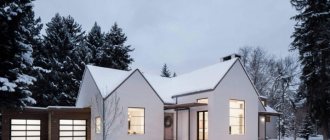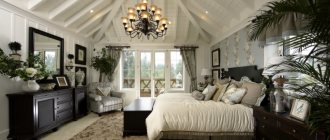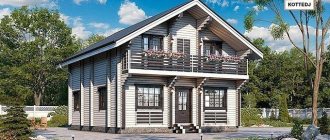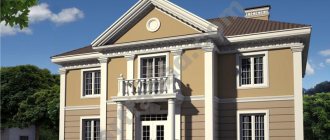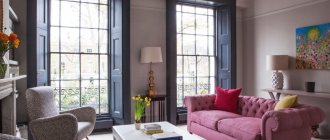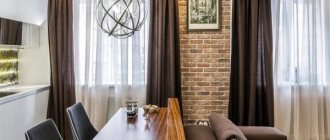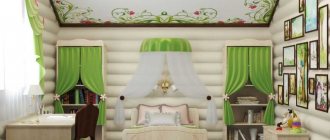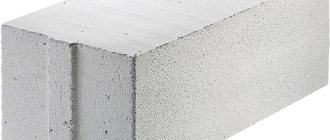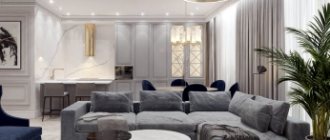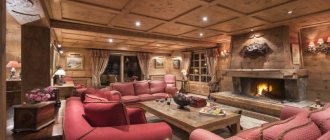their types, features and projects
English architecture is distinguished by an unusual combination of rigor and sophistication. Houses decorated in the English style have always been valued not only for their appearance, but also for their reliability and durability. Typically, a house of this style can be briefly described as a stone structure with a wide facade, decorated with plaster or brick. The design of such buildings looks luxurious and elegant.
In the photos of English-style houses you can see their main features.
The front side of an English style house typically features the following elements:
- the walls are made of natural stone or brick
- no carvings or designs
- the exterior is asymmetrical
- there are columns
- the range of colors used is quite narrow
- the roof has a round slope
- there is vegetation near the house
Types of English houses
In this type of architecture, there are three main directions, applicable to suburban and urban buildings. Each of them has its own characteristics and distinctive features.
Tudor style house
This building looks like a village house from a fairy tale, although it has a rather rough appearance. The main features of such houses:
- red brick laying
- high gables of different sizes located on the main facade
- the roof has a steep slope and uneven edges (may be thatched)
- presence of a large pipe
- small dormer windows
- asymmetrical general features
- arched entrance structure
Georgian type of architecture
In modern England, Georgian style is the most popular urban style. This style can look lush and formal, but it is also quite simple. Features of the direction:
- symmetry and right angles
- windows of equal size, evenly spaced
- lack of decoration
- the presence of five windows on the main facade
- low entry location
- paired pipes
- the roof with a low slope is located almost level with the walls
- on the side of the doors there are pilasters and semi-columns
Victorian type of architecture
Victorian style involves decorative cladding and contrasting color combinations in decoration. Style Features:
- roof with steep slopes
- asymmetrical look
- pediment overlapping the façade
- large veranda
- turrets of different shapes
- decorating walls using stone, half-timbering, siding
- the presence of ornaments, patterns, stucco moldings
- bay windows
- decorative supports, consoles
Features of English house projects
A house in true English style should be built of red brick. This material ensures a long service life. Another advantage is good sound insulation in interior spaces. In addition, brick buildings are resistant to temperature changes and humid environments.
The design of such a house assumes two floors, sometimes it may also have an attic. It is customary to place a utility room under the roof, for example, it could be a closet. Mainly creating a garden in the nearby area.
A typical English house design has an entrance in the middle of the building. The building, the facade of which is made in the traditional English style, looks massive.
Example of a house in English style photo:
An English-style building is characterized by a low foundation. The floor in it is almost level with the surface of the earth. There are usually no basements, but there may be a storage room or shallow cellar. The façade of an English house looks austere; decorations are allowed only in rare cases. It is not painted or veneered.
The windows on the first floor are low. The shape of windows is usually rectangular or square. The roof is high and sharp, covered with red tiles. Recently, you can often see roofs made of reeds or thatch.
A porch is rare in English houses. It is built only if the site with the house is on a slope. But there may be awnings over the entrance doors or windows. Ivy wrapped around a canopy will look luxurious.
Internal layout
The main room on the first floor is the living room. According to the rules, it should be combined with a dining room, corridor, and hall. The area should be bright - there should be a large number of windows in the rooms. There may also be a study area on the ground floor.
The second floor is the sleeping area. There can be three bedrooms here, and one of them should have a bathroom and wardrobe. This English style house project is ideal.
Traditional interior
A comfortable and cozy environment is an important condition for creating an internal atmosphere characteristic of the interior of a house in the English style. The main room here is the living room. It creates all the conditions so that guests can stay comfortably. At the same time, already at the stage of drawing up the project, the design style is strictly maintained.
Natural wood is used for decoration, the floor has parquet covering. It is preferable that the living room be large enough. However, by resorting to the help of designers, you can get a project of an impressively decorated house and a small size.
The design of the interior decoration of a house in the English style requires the presence of a fireplace, which is the center of the composition in the interior of the living room. Its cladding can be made of different materials (marble, wood, lime panel). On the mantelpiece, as a rule, a mantel clock, small bronze sculptures, porcelain figurines, vases with flowers, as well as snuff boxes and cigarette cases are installed.
Conclusion
Choosing a project for an architectural structure in the English style will not only be a beautiful and elegant solution for a country house, but will also become a comfortable and cozy place to live in it. A small house in the English style, surrounded by greenery, will remind you of centuries-old English traditions, including a relaxing holiday away from civilization. The interior and exterior, unusual for our places, will delight its owner every day. Well, green spaces, as part of a house of English architecture, will allow the owners and guests to always be in a good mood.
English style house project
Projects of cottages and houses.
Rate this article: Share with friends!
fasad.guru
Beautiful facades of brick houses: all the pros and cons
Content
- Advantages and disadvantages
- Finishing methods
- Types of bricks used for facade finishing
- Choice of color and style
The facade is the calling card of any building, because it is by it that everyone will judge the tastes and preferences of the home owner. Correct and attractive finishing of the facade can change the external perception of the house, making even the most modest and small house noticeable. Today, manufacturers of building materials offer the buyer a variety of materials and facade design options to choose from. However, despite the abundance, brick was and remains the best option.
A facade made of brickwork will decorate not only the house, but will also emphasize the unity of the house with the landscape. Brick is a material that combines both severity and elegance. Due to its practicality, it can be used both for finishing a house, a cottage, a bathhouse or a commercial building.
Advantages and disadvantages
- Long service life. Brick is a material with a high level of strength. It is resistant to the influence of natural factors and the loads placed on it. The material does not corrode, rot, is resistant to temperature changes and high humidity, which means it guarantees a long service life.
- Environmental safety, since the material is natural, made from natural raw materials.
- Fire safety. Brick is not combustible, spontaneous combustion is impossible, and this is a positive point when choosing a material.
- Soundproofing. Many people prefer silence, to move away from the bustle of the city and be alone with themselves and their thoughts. It is in a brick house that you can afford this, because thick and massive walls absorb most of the noise.
- Easy to care for. Brick is easy to clean, its maintenance will be as simple and convenient as possible.
- Great design potential. With the help of bricks you can make attractive houses for every taste. With the help of a brick you can open up new facets and possibilities.
There are many advantages, but we must not forget about the disadvantages:
- Price. The cost of the material is quite high, so not everyone can afford it. It is worth noting that the cost is justified, since the service life and the absence of the need to carry out repair work justify this.
- Impressive weight. To use bricks, it is necessary to lay a strong foundation and build strong walls.
- Thermal inertia. Brick does not heat up well, so you will have to carefully consider how the house will be heated, you will have to build a high-quality heating system, and also take care of good thermal insulation.
Finishing methods
In general, there are 4 types of finishing using the following materials:
- Facing brick.
- Decorative brick.
- Copying bricks with PVC panels.
- Corrugated sheeting imitating brick.
Types of bricks used for facade finishing
Natural brick is considered the best option for the facade, as it adds sophistication to the appearance of the house. However, aesthetic appearance is not the only parameter that you need to pay attention to, so you need to know about other types of bricks and their properties.
Sand-lime brick is inexpensive and simple in appearance, but has high-quality thermal insulation. This type of brick is easy to work with, its installation is quick, so you can do it yourself. The ideal option would be double sand-lime brick with a facing lining.
Hyper-pressed brick - made from limestone and shell rock, its price is an order of magnitude higher than the previous option. This type of brick has a variety of sizes and colors, and its long service life and frost resistance justify its cost.
Choice of color and style
With the help of the right color you can transform your home and change its perception. Thanks to the wide selection of brick materials, you can choose almost any shade of brick. Recommendations from experts on choosing a color palette:
- If the roof, windows and doors of the house are brown, then it is better to make the facade yellow.
- For minimalism, it is better to use white and make the roof black.
- Red and brown colors are best used for classic style homes.
- A combination of dark and light shades is suitable for masonry in the melange style.
- Using dark and light bricks, you can make a “frame” that highlights the entrance to the house.
- It is necessary to take into account not only the color of the brick, but also its texture.
Thanks to a wide selection of colors, types and textures, you can create unique facades that will be designed in accordance with a specific style.
The most popular styles that prefer the use of brick when finishing the facade:
- Romanesque. The building should be massive, have impressive walls, arches and colorful decor. Externally, the house should resemble an ancient Roman fortress; brick will become an ideal assistant and an integral part in finishing the facade.
- Gothic. A very popular style that prefers brickwork. Several types of brick are used for finishing; here they recognize a combination of both different colors and textures or types of this material.
- Baroque. A house that screams luxury cannot do without brick. Here they use only the most expensive and bright types of bricks, which can emphasize the wealth of the house and the wealth of its owner. Often brick is combined with wild stone.
- Timeless classic. Such a house will create a pleasant and cozy atmosphere; a combination of red and white bricks is used to decorate the facade. The shape of such a house will be standard, and the roof will be brown. The facade here is as simple as possible, without any frills or abundance of decor.
- High tech. This style and design of the facade is suitable for those who like to be extraordinary, to express themselves and their “I”. Natural brick is used to decorate the facade, but to maintain the style it must be combined with decorative glass or metal inserts.
Projects of houses and cottages in the English style
From our complete catalog of projects, here we have placed projects of houses and cottages in the English style, and those whose layout and proportions of facades make it easy to stylize them as traditional English architecture.
Strict, a little monotonous, gloomy and mysterious, but preserving centuries-old traditions, the English style of architecture is now liked by many.
Times are turbulent, and now, more than ever, I want to be able to enter the same favorite doors day after day and mow my favorite and familiar “three-hundred-year-old lawn” year after year. “Good Old England” has always been considered a stronghold of conservatism, and now everything reflecting its past seems to many to be a transmitter of the reliability and inviolability of life’s foundations and protection from possible shocks.
Today, when talking about projects of houses or cottages in the English style, they mean a rational plan, a fireplace, brick walls, a little white decor and a roof of medium steepness. It can be considered a variation of the classical style. You can choose a cottage project in a pure classic design here. Homes with a friendlier, southern flair, related to the Mediterranean style, on this page.
up
PROJECTS OF HOUSES AND COTTAGES IN THE ENGLISH STYLE
up
A LITTLE HISTORY. FEATURES OF THE ENGLISH STYLE IN RESIDENTIAL ARCHITECTURE
The concept of “English style”, now used in relation to projects of houses and cottages, is somewhat arbitrary and simplified. Historically, the style of English housing can be divided into three main large periods:
• Tudor style (XVI – XVIII centuries) – the “hoary antiquity” of English architecture. The buildings of that time are characterized by both brutality and romance - complex plans with numerous projections, steeply sloping multi-slope broken roofs, several high gables of various shapes and sizes, all kinds of turrets, an abundance of untreated stone and heterogeneous bricks. It is characterized by powerful walls, thick, tall chimneys, and small divisions of the frames of small windows. In general, “my home is my castle.” In modern designs of houses and cottages in the English style, sharp pediments are most often borrowed from this direction; other attributes can also be found today, but only in eclectic non-standard projects of expensive luxury villas.
• Georgian style (XVII - XIX centuries) gravitates towards the classics, differing from it in rougher, simplified forms, and again in brutality. This is the style of mass development of an ancient English city. Georgian houses are simple and rational, rectangular in plan, often with a symmetrical facade with three or five windows, with entrances under a balcony or bay window. Their brick walls are sparsely decorated, only around doors and windows, and a couple of pilasters or columns are allowed at the entrance. Roofs were no longer made so steep. Now, when talking about a house project in the English style, they usually mean Georgian, or Georgian with echoes of Tudor architecture. It is simple in execution, concise and quite expressive. Georgian housing can be described in one short phrase - a solid brick house.
• The Victorian style (XIX - early XX centuries) is very diverse, its representatives have in their appearance features of many other styles and movements: half-timbered houses, buildings in the Art Nouveau style, classical antique, Dutch, ancient English and many other directions of architecture. Life at that time, under the influence of technological progress, acquired lightness and diversity, and at the same time the architecture of residential buildings lost its reliability and solidity. The need to build strong and last is gone. But small details of the facades, large bay windows and stained glass windows, open colonnades, thin intricate turrets and short-lived siding trim appeared. It is almost not associated with English in modern design practice due to the loss of brutality and respectability.
www.invapolis.ru
Architectural features
The foundation of a typical English residential building is very low, so the floor surface practically coincides with the ground plane. You won’t be able to find the usual basements and garages in the house, since the English style does not imply this.
Sometimes owners can equip a small cellar or storage room in their home. The external façade is not decorated or clad in any way, so it looks rather rough.
Window openings of rectangular or square shape of the first level are located low. The roof of the house is covered with red tiles, its shape is sharp, and the structure is very high. In recent years, the roofs of English houses have been made of straw or reeds.
A porch is attached to a house only if the building is located on a site with a slope. But entrance doors and windows are often framed by awnings.
The ivy climbing along the canopy brings special luxury to the design of an English-style house. It is customary to plant small gardens and create picturesque flower beds next to English residential buildings.
Design and construction of houses in the English style
If you decide to order a project or construction of a house in the English style, then you definitely need to contact our construction company for these services!
Due to the remoteness of foggy England, We imagine this house in the English style is also quite foggy! Some people imagine huge ancestral castles, while others imagine a simple and laconic house with a lot of windows and a chimney on the side of the house. To make it easier for us to understand the design of English-style houses, let’s look at the main directions.
Building houses in the English style is becoming more and more popular today; after many years of building monotonous square houses, with plaster or simply made of “Italian” brick, houses in the English style look very fresh. Although such houses have been built for hundreds of years.
There are only 3 of them, and the first one in our review is the Tudor style. It was common in the 16th and 17th centuries, especially in the construction of country houses and estates. The main features of this style are the presence of a pronounced bay window, the presence of stone and brick as the facing material of the walls, stone and brick must also be combined with plaster and the presence of half-timbered windows on the main facade of the house, there is also a large pipe on the side of the house or a tall one, a dedicated pipe, which, due to its size, is an integral part of the facade of the house. Such a house is usually completed by several high gables and a high, sloping roof.
The Tudor style was replaced by the Georgian style. Its spread occurred in the 18th - 19th centuries; it is this style that is most associated with a private house in the English style, since the main English cities were built during the era of the spread of this style.
Compared to the Tudor style, this style may seem simple, since the facade of the house is quite laconic; it is made of plain brick, much less stone. Due to the symmetry of the facade, the house looks very strict. But still, the house looks very beautiful and stylish, due to the windows and doors highlighted with white ornaments, and sometimes the doors are painted in bright colors. Also, a lot of attention is paid to the entrance group here, a large porch, a door with pilasters and a viewing window above the door. The symmetry and severity are complemented by a low-raised roof and almost always 2 symmetrical pipes on both sides of the house.
Our view of the design of a house in the English style, the Victorian era of the 19th and 20th centuries, completes our view. Again, the facade of the house becomes complex, bay windows and verandas appear that unite several sides of the house, the use of stone and half-timbered wood returns to the cladding of the house, and patterns in the form of ornaments are added. In general, the houses have a complex shape, but the layouts are very functional and well thought out. This diversity is completed by a rather high roof with a turret and pediment overlooking the main facade; the roof overhang is decorated with wooden consoles.
At the moment, our portfolio includes both ready-made projects of English houses, and we also have the opportunity and experience of individual design and construction of such a house for the Customer. If you decide to design and build your house in the English style, you definitely need to contact us!
Projects of houses in the English style from the company Novatsiya
Contact phone number
krasnodar.ccnova.ru
The most popular varieties of English style:
- Gregorian
- Victorian
- Tudor
Gregorian style
In the Gregorian style, the motifs of ancient architecture are quite noticeable. As a rule, houses in this style are two-story. The first floor of the house has a high base and wall coverings in the form of cornices and moldings. The doors are made of wood, sometimes with small windows at the top.
The walls are most often made of red brick; visually it looks like a classic brick house in the English style, reminiscent of a fairy-tale construction from the Middle Ages. The presence of artificial or wild stone in the facade of the house is also a clear characteristic of the style. Facade cladding is often found using foam or polyurethane. These materials are light in weight and quite versatile, they can be easily painted to match natural materials.
Wonderful English style house designs
Fifteen kilometers from the center of London is the village of Wimbledon Village, famous for its proximity to the main courts and sports clubs of the country. Any visitor to the "Beautiful Country House" would be enchanted by this place, its cafes and shops, and its special atmosphere. And of course, the villas, which exude respectability, deserve special attention.
When imagining a home in Europe, you can use two cottages built in 2014 on Ellerton Road as a source of ideas. They were named after women - Augusta and Sofia, and although these are two separate properties, they are united by a common style and richness of decoration. The first building is made of yellow, and the second of red brick.
Newcourt Residential, the company that created these works of architectural art, took as a basis the features inherent in buildings of the Victorian era. However, the lower floors are reserved for swimming pools, saunas and relaxation rooms, which allows residents to experience the beauty of modern solutions and ways to find comfortable conditions.
The social area is well thought out, which is divided into a spacious dining room, a living room opening onto the garden and a functional kitchen. The top floor is dedicated to the bedrooms, which are luxuriously decorated and include truly large walk-in closets. Guests can enjoy views of golf courses and manicured courtyards.
The landscape design of the site amazes with its splendor. Absolutely all the details fit into one composition, bright and immensely elegant. The spirit of England itself is felt in expensive furniture, the best materials and skillfully crafted lawns and bushes.
designerdreamhomes.ru
Porch in Oriental style
By this designation we mean Japanese or Chinese architecture. Both provide a circular terrace around the house, which acts as a porch. And the material for it is stone and wood, but not steel. It’s hard to even imagine a photo of a modern Japanese courtyard whose house would be decorated with decorative forging.
It should be understood that here we are dealing with closed cultures that accept everything new with extreme wariness and at the same time reverently preserve their traditions. If you don’t like the stated rules, don’t be too sophisticated; choose a simpler look for your porch.
Country houses in English style in St. Petersburg. Features of English architecture.
When we talk about an English house, the famous expression “my home is my castle” immediately comes to mind. But it would be a mistake to believe that Britain is famous only for its medieval castles in the Romanesque and Gothic styles. The aphorism applies only partly to architecture and implies, first of all, the inviolability of the home and its closeness from outsiders. In their houses, the British always obeyed European architectural fashions, but introduced a bright national flavor into them. One thing is undeniable - English buildings are always built to last: reliably and extremely practical. Historically, there was little use of wood in England as forests on the island were limited and in private hands. Buildings were erected from locally available materials - stone and brick, which are less susceptible to the influence of time than wood.
To this day, a lot of such buildings have been preserved throughout England - from farmhouses to family mansions, which preserve the spirit of old England.
History of English architecture
Over many centuries, in England, as in other European countries, many styles have changed - from Romanesque and Gothic to modern high-tech. The most “classical” among them are the Tudor, Georgian and Victorian styles. Each is interesting in its own way and still arouses the interest of modern homeowners. From Tudor times, “fairytale” country houses made of brick and stone with elements of wooden half-timbering - a frame that was filled with brick, fragments of stones and clay, and sometimes plastered on the outside - have been preserved. A striking example of the Tudor style is Anne Hathaway's house, where, according to legend, Shakespeare's wife spent her childhood. The house is built on a timber frame and topped with a thatched roof.
In the elite versions of Tudorian buildings, you can find elements from past eras - Gothic and Renaissance. Rich plastic, multi-gable roofs, and figured window sashes made the facades of the houses varied and very attractive. The style also finds its admirers in modern architecture, but the traditional half-timbered structure is replaced with its imitation, when the wall plane is decorated with overhead wooden blocks.
The generalized image of an ancient building is captured in the house project K-136-1P from ABC of Construction. In a miniature copy of an English house, you can find features of the Tudor style - a simple plan, rough stone, Gothic decorative elements made of wood.
The Georgian estates, which predominated in the 18th century, are an English version of the Palladian villa. Calm and harmonious buildings with a symmetrical composition and restrained decoration of the facades - this is exactly what we imagine a classic English house, familiar from films and books, looks like. The British drew beauty and expressiveness not from the abundance of details - columns, sculptures, stucco moldings, but from the simplicity and grace of large windows with a graphic pattern of frames, in snow-white stone decor against the backdrop of brick walls. The wealth of the owners was indicated by two chimneys above the roof, indicating the presence of two fireplaces.
Based on the Georgian style, the architects of ABC Construction created several projects. The project according to which we built a house in Pushkin, in its structure, is an English version of a “Palladian villa” with classical symmetry, a small base, a brick facade, restrained decorative details - rustications, cornices, windows with small frames.
Another project in the English style is L-234-1K, from our partners. A spectacular entrance portico with a balcony on the second floor, as well as the contrast of red and white brick, create an elegant façade of the house that will retain its pristine freshness for many years.
The restrained and strict Georgian style was replaced by Victorian architecture (mid-19th - early 20th centuries) - free, diverse and democratic: under Queen Victoria, the middle class acquired great importance - its representatives built luxurious mansions in which they tried to combine all the best in the entire history of architecture. Gothic, Renaissance, and oriental motifs were complemented by stained glass windows, bay windows, and round ship windows. Modern architects still draw inspiration from this abundance of details, freely combining them in projects of “English” mansions.
A historical sketch of a Victorian house shows a great variety of architectural elements. Multi-colored brickwork, a peaked roof, turrets, columns, and wooden carvings were intricately combined in one project.
Elements of an English home
Despite the stylistic differences, an English house can be identified by several characteristic elements:
1) Facades made of stone and brick, often using figured masonry, which replaces stone decor. With the help of bricks of different colors, textures and sizes, you can create patterns and form complex plastic: sandals over windows, rustication - imitation of stone slabs, keystones, horizontal rods, cornices and much more. It is with such expressive means that the image of a solid, discreet house is achieved.
The brickwork imitates the stone decoration of the facade: rustication, frieze - a wide strip under the cornice, a belt separating two floors, paneled window frames. These details tactfully hint at the owners’ commitment to quiet classics - cozy and homely, and not museum-style.
Figured bricklaying requires high professionalism, accuracy and attention to detail from the master. In the photo, a mason from ABC of Construction is laying out sandrik with a decorative cracker motif.
2) Multi-pitched roof with gables, low base, lack of a high porch, two floors with an attic and, much less often, an attic. In the modern interpretation, certain details can be transformed. For example, in the i-200-1k project, the full second floor is replaced with an attic with sloping windows and a magnificent dormer with a pediment that adorns the main facade.
English style in Russian conditions
English-style mansions are very attractive to Russian homeowners. Thanks to reliable materials, they are built to last and look respectable and solid for many years, without requiring repairs or renovations. At the same time, due to English restraint and practicality, the houses are devoid of the pathos that distinguishes many classical buildings. And yet, Russia is not England, and when reproducing the style in Russian realities, a number of nuances must be taken into account - climatic conditions, technological features, etc. Getting to know them will help you avoid unpleasant surprises.
Architect Konstantin Buchelnikov, partner, distinguishes three degrees of perception of a house:
1) Silhouette – proportions, shapes, scale of the house. At this stage, the foundation of the project, created by a professional architect, is laid. Russian soils often do not allow the use of a low base, common in England, and architects have to find a compromise between purity of style and functionality. Mandatory conditions for construction are good waterproofing, drainage, and the use of high-quality stone for finishing the base.
In the AC-230 project, low floor-length windows with a balcony door lead directly to the garden - just like in a real English house. The trick is in the stepped terraces, which raise the level of the building and hide the high base.
2) The second level of perception of the house is its exterior - facade details, windows, roof elements - ridges, gables. The quality of materials is of particular importance: brick, stone, windows, tiles, etc. Currently, such buildings are built from aerated concrete or porous bricks, followed by insulation and clinker brick cladding. Textured or aged brick – ideally hand-molded – looks especially impressive.
In the event that rustication and other decor is made of stone, the elements are laid in the thickness of the wall, and not on top of the built facade. To do this, different specialists must work in a team - the stone is laid after the brick, and then the brick again. Only a good contractor who is familiar with such nuances can ensure a smooth process.
The process of building a house from. The walls are made of porous brick with thermal insulation, facing with decorative brick and granite on the base.
An English house has a complex, multi-pitched roof, sometimes decorated with turrets. The classic version uses ceramic tiles, but it can also be replaced with a soft roof. In any case, you should not rely on the technology of past centuries and protect your roof from leaks with just tiles. A prerequisite for a modern, reliable roof is good waterproofing.
3) The last, but no less significant stage of recreating the style is the selection of accessories that are noticeable upon close examination. When ordering “classic” windows with frequent frames, do not forget about the fittings - cheap plastic handles do not suit a reputable home. The same can be said about additional elements for the roof and drainage system. It is better to replace white plastic pipes with authentic copper accessories.
A copper chimney cap in the shape of a charming house will definitely attract attention and contribute to the creation of the image.
Competently working out all three levels of perception of a building is a difficult task that ABC of Construction specialists face every day. But it is precisely this approach that guarantees the desired result: a spectacular house with a bright, memorable image, where all the details are in harmony with each other. A house that is built conscientiously and will become a reliable “fortress” for its owners and a heirloom for the whole family.
www.azbuka-stroy.ru
Porch in half-timbered style
Let's step back from the classical canons and begin our debriefing with the most interesting architectural direction of Fachwerk. Originating in the middle of the 15th century in Germany, it very quickly gained popularity in the countries of Western and Northern Europe, and in the 21st century it received many adherents in the post-Soviet space.
The main feature of the style is the load-bearing elements of the frame, which are displayed here in a natural texture. Posts, beams, slants... if you look closely at a porch built according to German canons, you will notice all these details in the canopy design. And there will definitely be a wild stone there, or at least a reliable imitation of it.
Brick house in English style - Your dream home
The Highgate residence in North London has many surprises for you. From the outside, the front of the house looks like an old brick English style house that has remained untouched for the past few decades. However, step inside and you will be amazed by the brilliant contrast. Modern soft interior, through which a minimalist style clearly appears. Updated by Thomas Grim, design director at Studio TG, Highgate captures a contemporary feel without sacrificing a stylish look.
Situated on multiple levels of the building, the homeowners wanted a more open and spacious interior that would allow for ample natural ventilation. The interior layout redesign also confirms that a more open floor plan is now in vogue, using glass to bring in plenty of natural light. Using one color also helps create a cool minimalism. A clean and well-defined layout combined with modern decoration helps to highlight the chic and neat design.
Accents of green have been placed throughout the home, giving it a hint of Scandinavian charm, while stunning light fixtures make this English style feel more homey. The beautiful staircase with glass railings forms the main feature of the Highgate house and makes a wonderful sculptural addition. The upper three floors are dedicated to private quarters, containing bedrooms and bathrooms, while the lower levels of the house are dedicated to the dining room, kitchen and living room.
Foundation and roof features
The foundation of English houses is almost invisible. The floor is laid on a thin layer of foundation, almost on the ground part of the ground. Another feature of the houses is that it is not customary to place garages or any workshops in the basement of the premises.
As a rule, the facade is rarely painted or covered. In rare cases, brick materials or light plaster are used for facing work. Mostly elements such as doors, windows and cornices are painted.
The facade of English-style houses has a high roof. The roof is most often made from materials such as slate, tiles or even thatch.
If in ancient times roofs made from natural materials indicated the weak financial situation of the owners, then in modern times such materials are highly valued and are considered environmentally friendly.
Among such materials, straw, reed and reed remain the most popular.
The features of the roof are its height and sharpness. The roofs of English houses are multi-pitched with gables. Such roofs are covered with tiles. Recently, roofs made of thatch have become the most popular.
Porch in Provence style
Provincial Prvans can be considered the antipode of the brutal Loft. In house construction, this is careless already peeling masonry, artificially aged surfaces, and the predominance of calm beige tones. The role of architectural decor is minimized, and the color is created thanks to many small exterior details and fresh flowers.
Porch in Loft style
Loft is one of the most sensational interior styles of our time, and yet in architecture it is, to put it mildly, rare. The secret is in the style features. After all, a loft is essentially an abandoned and then lived-in enterprise. And having a house in the yard in the form of a factory workshop is not a very tempting prospect.
And yet, if such an idea has occurred to you, then remember that the loft porch will also have manufacturing components:
- it could be a simple steel visor;
- metal welded staircase;
- or a copy of the factory pass.
Situations are also possible when the “attic” threshold will not have any canopy at all. Just a concrete platform and sliding doors, minimally protected by the roof overhang.
Porch in Post-Soviet style
The shortage of building materials, small plots of land and the complete decline of the institution of private construction led to the emergence of the so-called Post-Soviet architectural style. If we look at it using the example of a porch, we can easily highlight two main points.
- Modest dimensions dictated by the available space.
- And a minimal amount of decor.
During the time of the leaders of the proletariat, the artistic component was completely sacrificed for the sake of functionality. The porch was supposed to, first of all, protect its owners from bad weather, perhaps shelter a couple of bags of potatoes, and with the rest, whatever happens. Our examples will confirm this better than any words.
Style Features
At the beginning of the second millennium, in what is now England, houses were built from wood or natural stone. Then a half-timbered version appeared: a frame made of beams and logs and walls made of scrap materials. This is stone, clay, wood. Half-timbered structures are durable. An example is the Shakespeare House Museum in Stratford-upon-Avon, which dates back to the 16th century. The only drawback of such structures is the fire hazard, and fires occurred frequently in England. With the arrival of immigrants from the Netherlands, the building material changed. Most of the surviving houses are built of dark red brick.
Popular varieties
The English architectural style was influenced by various historical eras. Each of them was characterized by features that somewhat changed the classic appearance of an English house and its decor. Photos of buildings that have survived to this day allow us to trace how an English-style house was transformed depending on the time of construction.
Porch in Eco-style
If the organic style adapts to the existing landscape in spirit. The eco-style completely mimics the environment. Its adherents have an incredibly difficult task to create an environmentally friendly, autonomous house that is part of nature.
And here again, no one will look closely at the porch, or attach a standard, wrought-iron canopy over the front door, because in most cases a lawn has yet to be laid out on it.
This is how the picture turns out. Of course, this short list cannot contain the entire range of architectural styles known to science.
But this is not required, because not all historical experiments are relevant in the 21st century, and certainly not all of them are applicable in private construction. Therefore, dare, study, put into practice and let the power of the building level and roulette be with you.
